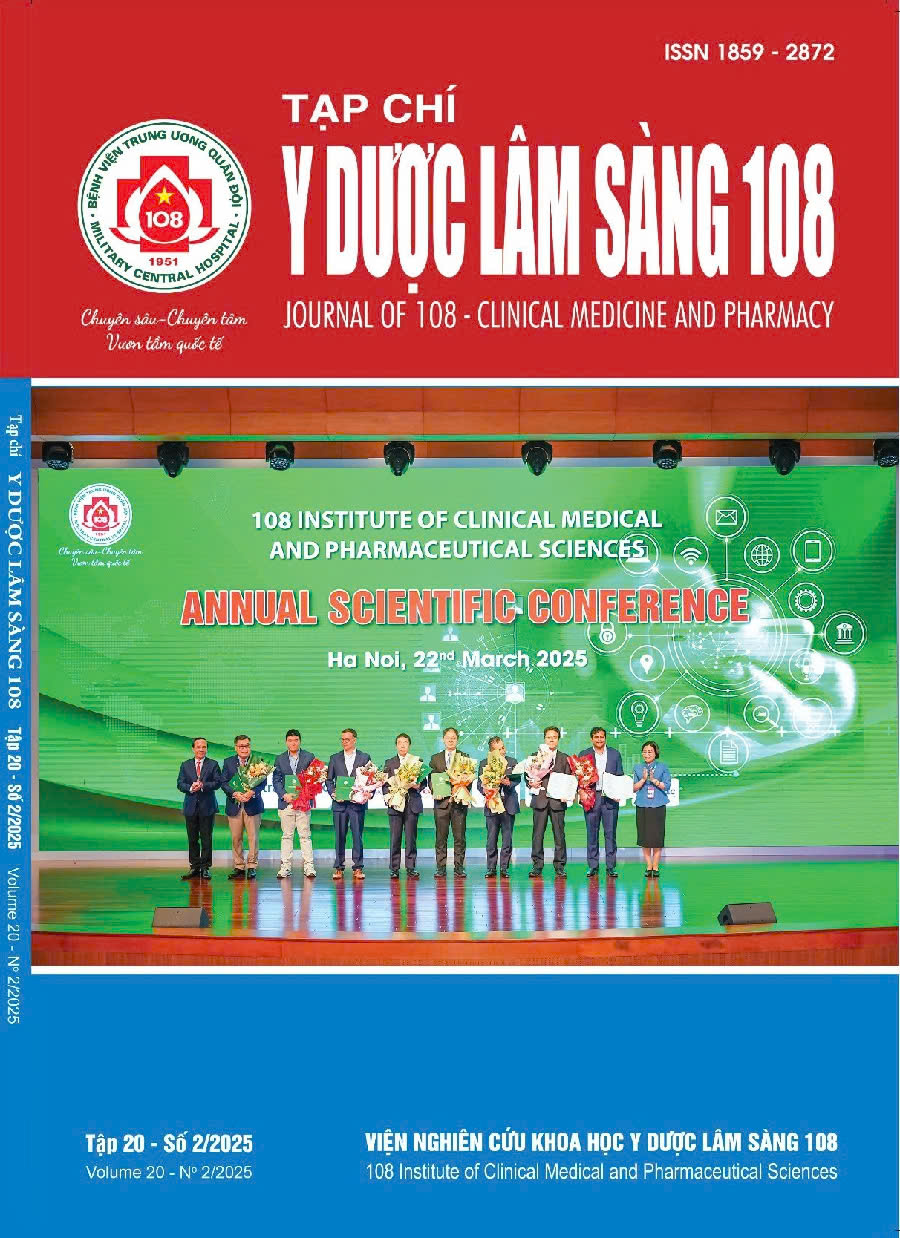So sánh hiệu quả trao đổi khí của phương pháp oxy lưu lượng cao dòng 40 lít/phút với 70 lít/phút khi ngừng thở trong phẫu thuật nội soi dây thanh
Main Article Content
Keywords
Tóm tắt
Mục tiêu: Mục đích so sánh hiệu quả trao đổi khí của phương pháp cung cấp oxy lưu lượng cao (highflow oxygenation) dòng 40 lít/phút với 70 lít/phút khi ngừng thở (apnoeic) trong gây mê phẫu thuật nội soi dây thanh. Đối tượng và phương pháp: Từ tháng 10 năm 2022 đến tháng 12 năm 2024 tại Bệnh viện Trung ương Quân đội 108, 122 bệnh nhân (BN) từ 24-77 tuổi có chỉ định phẫu thuật nội soi dây thanh được chia làm hai nhóm: Nhóm HF40 được kiểm soát thông khí bằng phương pháp cung cấp oxy lưu lượng cao qua mũi (HFNC) dòng 40 lít/phút, nhóm HF70 sử dụng dòng 70 lít/phút. Trong quá trình cung cấp oxy lưu lượng cao, bệnh nhân được gây mê đường tĩnh mạch, giãn cơ hoàn toàn và mà không thông khí trong phẫu thuật. Kết quả: Thời gian ngừng thở và thời gian phẫu thuật hai nhóm khác biệt không có ý nghĩa thống kê lần lượt là 18,70 ± 2,56 phút và 18,20 ± 2,29 phút, 17,15 ± 2,52 phút và 16,61 ± 2,13. Độ bão hòa oxy máu ở hai nhóm ổn định trong tất cả các thời điểm từ 99-100%. Trong giai đoạn sử dụng oxy lưu lượng cao, PaO2 của hai nhóm nghiên cứu đều duy trì trên 200mmHg, đảm bảo đủ cung cấp O2 cho cơ thể. PaO2 tại các thời điểm của nhóm 70 lít/phút đều duy trì cao hơn có ý nghĩa thống kê với p < 0,05 so với nhóm 40 lít/phút. Tất cả các bệnh nhân ở cả hai nhóm đều có tình trạng toan hô hấp cấp, tuy nhiên hoàn toàn trở về bình thường sau 15 phút thoát mê, không có sự khác biệt về các chỉ số khí máu giữa hai nhóm. Tỷ lệ bệnh nhân đau họng, khô miệng nhóm HF40 ít hơn có ý nghĩa thống kê nhóm HF70 với p<0,05. Không gặp biến chứng chảy máu, tràn khí, tràn máu, chấn thương phổi áp lực ở cả hai nhóm. Kết luận: Trong phẫu thuật nội soi dây thanh, phương pháp cung cấp oxy lưu lượng cao qua mũi dòng 40 lít/phút và dòng 70 lít/phút có thể đảm bảo hiệu quả trao đổi khí an toàn. Trong thời gian ngừng thở, tất cả bệnh nhân ở hai nhóm đều có toan hô hấp cấp, tuy nhiên hoàn toàn trở về bình thường sau 15 phút thoát mê. Tỷ lệ bệnh nhân đau họng, khô miệng nhóm HF40 ít hơn nhóm HF70.
Article Details
Các tài liệu tham khảo
2. Patel A and Nouraei SR (2015) Transnasal Humidified Rapid‐Insufflation Ventilatory Exchange (THRIVE): a physiological method of increasing apnoea time in patients with difficult airways. Anaesthesia 70(3): 323-329.
3. Flach S, Elhoweris A, Majumdar S, Crawley S, Manickavasagam J (2019) Transoral laser microsurgery using high‐flow nasal cannula oxygenation: Our experience of 21 cases. Clinical Otolaryngology 44(5): 871-874.
4. Hermez LA, Spence CJ, Payton MJ, Nouraei SAR, Patel A, Barnes TH (2019) A physiological study to determine the mechanism of carbon dioxide clearance during apnoea when using transnasal humidified rapid insufflation ventilatory exchange (THRIVE). Anaesthesia 74(4): 441-449.
5. Lyons C and Callaghan M (2017) Apnoeic oxygenation with high‐flow nasal oxygen for laryngeal surgery: a case series. Anaesthesia 72(11): 1379-1387.
6. Ma B, Liu F, Wang D, Zhong R, Lin K, Li S, Zhang J, Li C (2022) High-flow nasal cannula in nonlaser microlaryngoscopic surgery: A prospective study of 19 cases in a chinese population. BMC anesthesiology 22(1): 1-7.
7. Gustafsson IM, Lodenius Å, Tunelli J, Ullman J, Jonsson Fagerlund M (2017) Apnoeic oxygenation in adults under general anaesthesia using Transnasal Humidified Rapid-Insufflation Ventilatory Exchange (THRIVE)–a physiological study. BJA: British Journal of Anaesthesia 118(4): 610-617.
8. Yang SH, Wu CY, Tseng WH, Cherng WY, Hsiao TY, Cheng YJ, Chan KC (2019) Nonintubated laryngomicrosurgery with transnasal humidified rapid-insufflation ventilatory exchange: A case series. Journal of the Formosan Medical Association 118(7): 1138-1143.
 ISSN: 1859 - 2872
ISSN: 1859 - 2872
